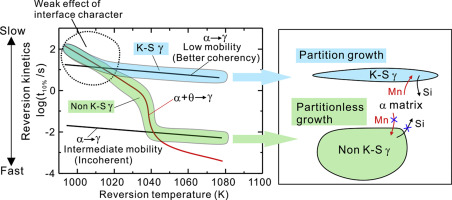当前位置:
X-MOL 学术
›
Acta Mater.
›
论文详情
Our official English website, www.x-mol.net, welcomes your feedback! (Note: you will need to create a separate account there.)
Growth mode of austenite during reversion from martensite in Fe-2Mn-1.5Si-0.3C alloy: a transition in kinetics and morphology
Acta Materialia ( IF 9.4 ) Pub Date : 2018-08-01 , DOI: 10.1016/j.actamat.2018.05.035 Xianguang Zhang , Goro Miyamoto , Takeshi Kaneshita , Yasuki Yoshida , Yuki Toji , Tadashi Furuhara
Acta Materialia ( IF 9.4 ) Pub Date : 2018-08-01 , DOI: 10.1016/j.actamat.2018.05.035 Xianguang Zhang , Goro Miyamoto , Takeshi Kaneshita , Yasuki Yoshida , Yuki Toji , Tadashi Furuhara

|
Abstract The kinetics and element partitioning during austenite (γ) reversion from lath martensite in Fe-2Mn-1.5Si-0.3C (mass%) alloy have been investigated. Two different types of γ in terms of crystallography, with Kurdjumov-Sachs (K-S) and without K-S orientation relationships with respect to the surrounding tempered martensite matrix, are formed. A transition in kinetics and element partitioning is related to the differences in crystallography. At low temperature, the growth of both types of γ is accompanied with the partitioning of Mn and Si. Consequently, the growth rates and appearance of the K-S and non K-S γ are similar and the reverted γ structure consists of acicular γ dominantly. On the other hand, at high temperature, only the K-S γ grows with partitioning of alloying elements in contrast to the partitionless growth of the non K-S γ, which leads to the formation of coarse globular γ. DICTRA simulation reveals that the variations in driving force for reversion and the interface mobility induce the transition of element partitioning. At large driving force and interface mobility, partitionless growth is possible and consequently coarse globular γ is formed by the fast growth of the non K-S γ at high temperature. On the other hand, reduction of the driving force or interface mobility induces the transition from partitionless to partitioning growth, which results in the dominant formation of thin acicular γ at low temperature.
中文翻译:

Fe-2Mn-1.5Si-0.3C合金马氏体回复过程中奥氏体的生长模式:动力学和形貌的转变
摘要 研究了 Fe-2Mn-1.5Si-0.3C (mass%) 合金板条马氏体转化奥氏体 (γ) 过程中的动力学和元素分配。就晶体学而言,形成了两种不同类型的 γ,相对于周围的回火马氏体基体,具有 Kurdjumov-Sachs (KS) 和不具有 KS 取向关系。动力学和元素分配的转变与晶体学的差异有关。在低温下,两种类型的 γ 的生长都伴随着 Mn 和 Si 的分配。因此,KS 和非 KS γ 的生长速率和外观相似,并且回复的 γ 结构主要由针状 γ 组成。另一方面,在高温下,与非 KS γ 的无分配生长相反,只有 KS γ 随着合金元素的分配而生长,这导致粗球状γ的形成。DICTRA 模拟表明,反转驱动力和界面迁移率的变化导致了元素分配的转变。在大的驱动力和界面迁移率下,无分区生长是可能的,因此非 KS γ 在高温下的快速生长会形成粗球状 γ。另一方面,驱动力或界面迁移率的降低导致从无分区到分区生长的转变,这导致在低温下主要形成薄针状γ。无分区生长是可能的,因此在高温下非 KS γ 的快速生长会形成粗球状 γ。另一方面,驱动力或界面迁移率的降低导致从无分区到分区生长的转变,这导致在低温下主要形成薄针状γ。无分区生长是可能的,因此在高温下非 KS γ 的快速生长会形成粗球状 γ。另一方面,驱动力或界面迁移率的降低导致从无分区到分区生长的转变,这导致在低温下主要形成薄针状γ。
更新日期:2018-08-01
中文翻译:

Fe-2Mn-1.5Si-0.3C合金马氏体回复过程中奥氏体的生长模式:动力学和形貌的转变
摘要 研究了 Fe-2Mn-1.5Si-0.3C (mass%) 合金板条马氏体转化奥氏体 (γ) 过程中的动力学和元素分配。就晶体学而言,形成了两种不同类型的 γ,相对于周围的回火马氏体基体,具有 Kurdjumov-Sachs (KS) 和不具有 KS 取向关系。动力学和元素分配的转变与晶体学的差异有关。在低温下,两种类型的 γ 的生长都伴随着 Mn 和 Si 的分配。因此,KS 和非 KS γ 的生长速率和外观相似,并且回复的 γ 结构主要由针状 γ 组成。另一方面,在高温下,与非 KS γ 的无分配生长相反,只有 KS γ 随着合金元素的分配而生长,这导致粗球状γ的形成。DICTRA 模拟表明,反转驱动力和界面迁移率的变化导致了元素分配的转变。在大的驱动力和界面迁移率下,无分区生长是可能的,因此非 KS γ 在高温下的快速生长会形成粗球状 γ。另一方面,驱动力或界面迁移率的降低导致从无分区到分区生长的转变,这导致在低温下主要形成薄针状γ。无分区生长是可能的,因此在高温下非 KS γ 的快速生长会形成粗球状 γ。另一方面,驱动力或界面迁移率的降低导致从无分区到分区生长的转变,这导致在低温下主要形成薄针状γ。无分区生长是可能的,因此在高温下非 KS γ 的快速生长会形成粗球状 γ。另一方面,驱动力或界面迁移率的降低导致从无分区到分区生长的转变,这导致在低温下主要形成薄针状γ。



























 京公网安备 11010802027423号
京公网安备 11010802027423号